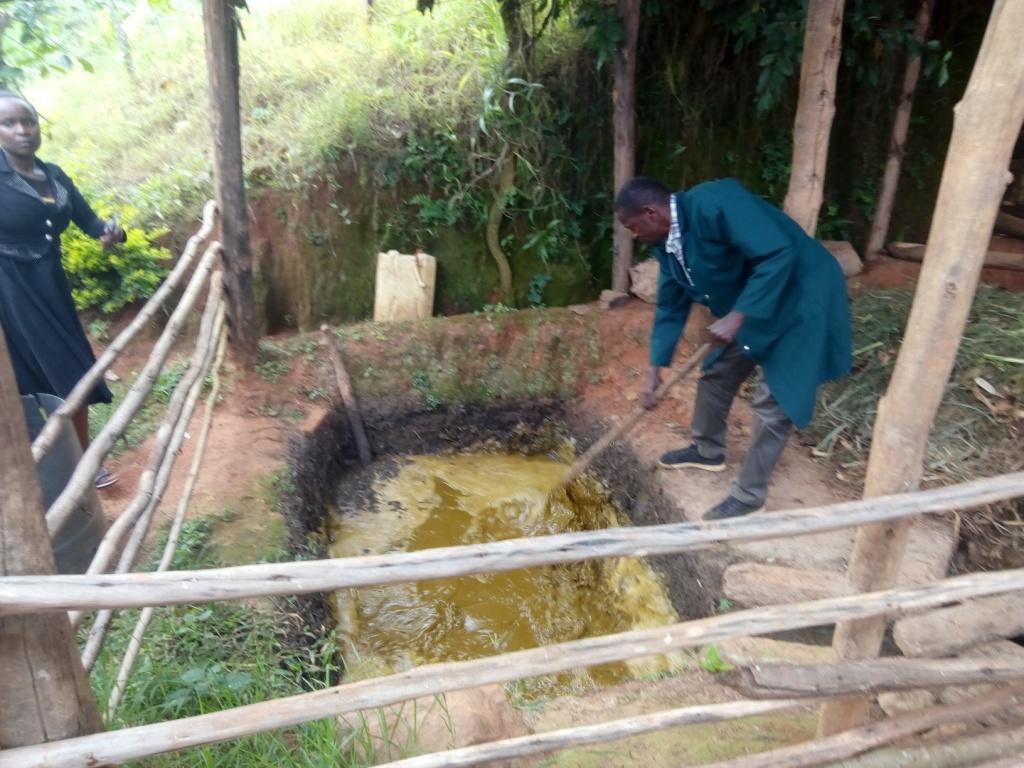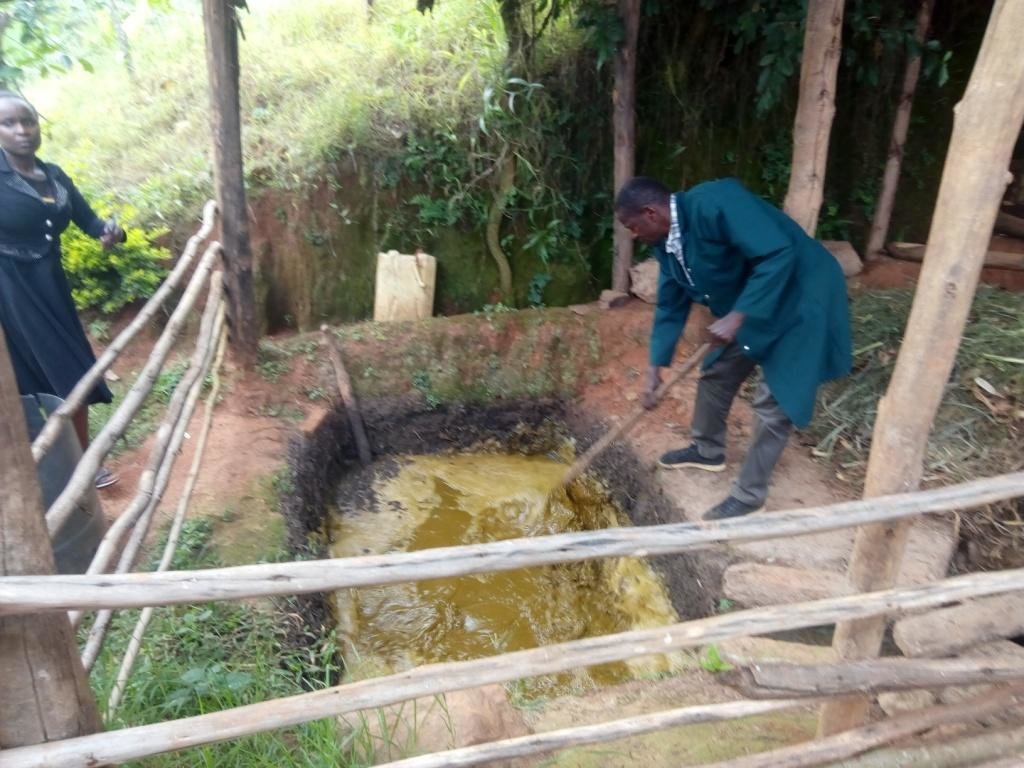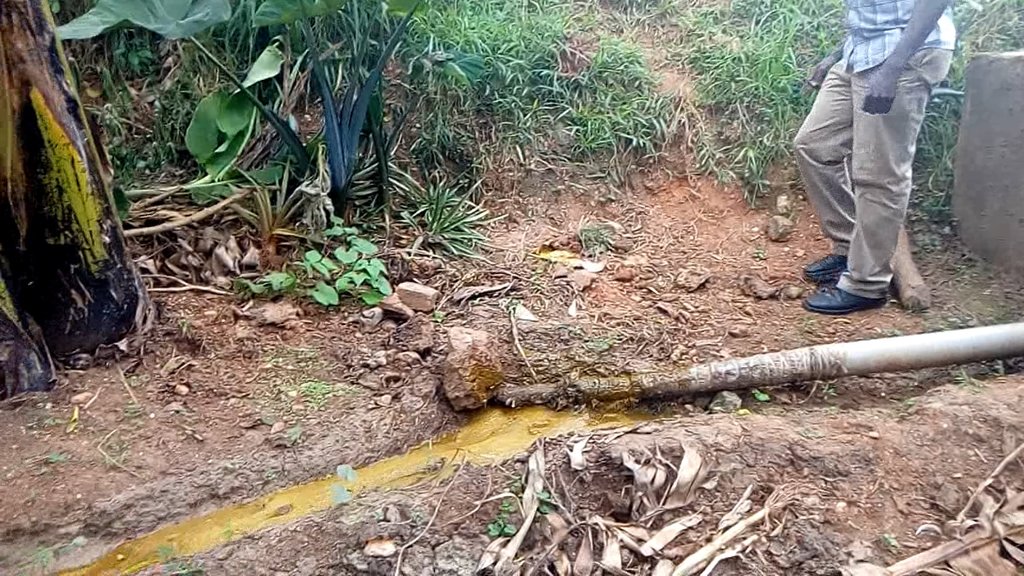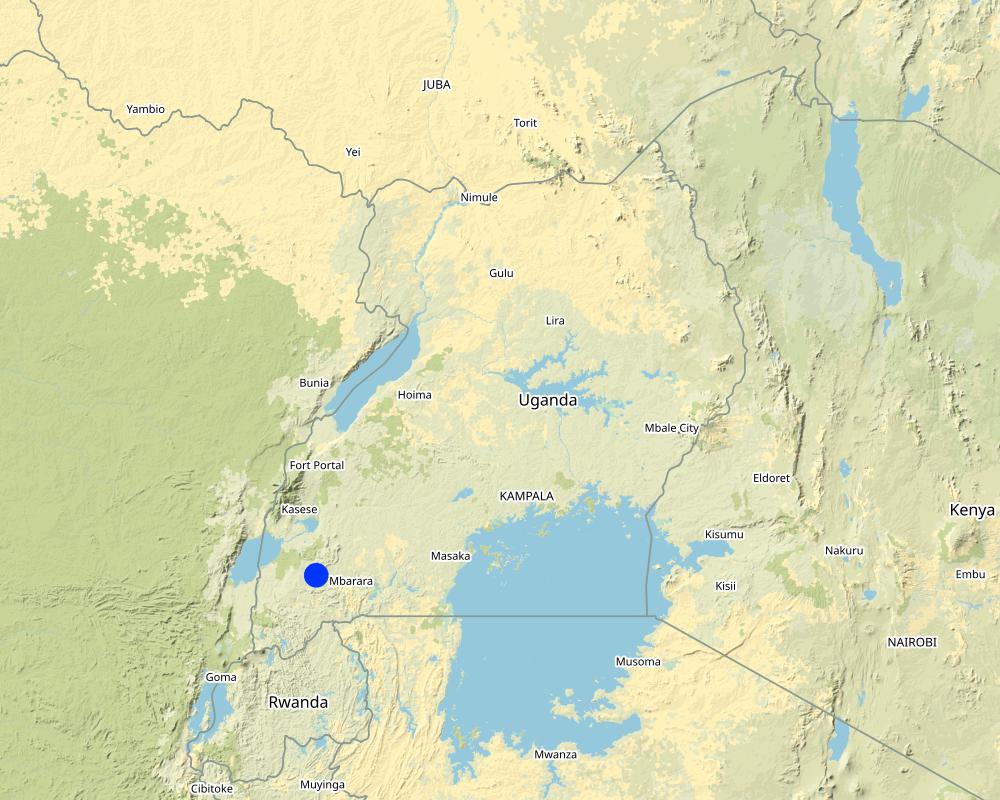BANANA PLANTATION INTEGRATED FERTILIZER-IRRIGATION TECHNOLOGY [Uganda]
- Creation:
- Update:
- Compiler: Aine Amon
- Editors: Drake Mubiru, Kamugisha Rick Nelson
- Reviewers: Nicole Harari, Udo Höggel
Okushukyerera na okuteka amasha omurutokye
technologies_3365 - Uganda
View sections
Expand all Collapse all1. General information
1.2 Contact details of resource persons and institutions involved in the assessment and documentation of the Technology
Key resource person(s)
land user:
1.3 Conditions regarding the use of data documented through WOCAT
When were the data compiled (in the field)?
23/01/2018
The compiler and key resource person(s) accept the conditions regarding the use of data documented through WOCAT:
Yes
1.4 Declaration on sustainability of the described Technology
Is the Technology described here problematic with regard to land degradation, so that it cannot be declared a sustainable land management technology?
No
Comments:
The technology helps improve soil fertility and maintain soil moisture in a banana plantation by using diluted cow dug from a zero grazing kraal.
2. Description of the SLM Technology
2.1 Short description of the Technology
Definition of the Technology:
The irrigation fertilizer system is an innovation designed to distribute manure and water in a banana plantation. A kraal (livestock zero grazing shed) with a cow dung reservior, set up uphill and connected with pipes to deliver diluted cow dug to a banana plantation downslope. This reduces the labor required for waste management at the Kraal while maintainig soil fertility.
2.2 Detailed description of the Technology
Description:
The Kraal (livestock zero grazing shed) was initially designed with a waste management system to hold cow dug in a reservoir for 1 to 2 months before being used in a 2-acre garden as manure. However, the farmer faced challenges transporting and distributing manure to the garden which was tedious and time wasting.
The dung from 4 cows is first mixed with water at a ratio of 1 (dung): 3 (water) as it drains into the reservoir producing approximately 1,500 litres of liquid manure monthly. Therefore, a pipe outlet was devised at the base of the cow dung reservoir to transport the waste 50m down-slope into 3 other reservoirs (each 2×1×1m, l×w×h) evenly distributed within the garden. These reservoirs store the liquid manure until the farmer wishes to fertilize the garden.
The garden preparation starts with clearing the weeds and then excavating small trenches that direct the flow of the liquid manure to any direction of interest in the garden. At different points along the flow in the trenches, the farmer opens tributaries leading to pits dug at least 0.75 m away from the banana plantains of interest. The pits made are normally approximately of 12.5 litres capacity. The trenches, tributaries and pits are then covered with soil after a day. This integrated fertilizer-irrigation system can only be possible on farms established on a gently sloping terrain. To set up the system one must have an animal house or any other source of animal dung uphill. The source must be able to provide enough dung to sustain the gardens established downhill.
Alternatively, the system can also be set up with a biogas plant replacing the cow dung reservoir to produce biogas for domestic energy supply and the slurry being used as manure. In case of such modification, the biogas should be set up at a slightly elevated position to give the liquid digestate a gravity force to flow to the garden. A foundation is excavated and a mixing chamber (50 litres capacity) constructed at some distance away from the farm house as well as 3 reservoirs to store the digestate (of a capacity at least 400 litres each) sited in the garden. An outlet pipe is fixed at the bottom of the mixing chamber through which the slurry can be channelled into the garden after the fermentation process producing biogas has stopped.
The construction process of the system without the biogas plant cost the farmer labour worth USD $ 13.44, construction materials were USD $ 251.04 and equipment USD $ 32.25. According to the farmer, the system is averagely expensive in the short run but profitable in the long run.
The system eases waste management and reduces costs of labour. The farmer, over the last 3 seasons realized improvement in the number of banana bunches harvested from averagely 50 to 60 bunches per month. The bunch weight also increased from 8-15Kg to 10-25Kg on average which is important for food security and livelihood.
The impacts of drought on the plantation have reduced compared to the time before adopting the technology. The farmer recommends upscaling since it is easy to manage, it improves productivity and is environment friendly. The major challenge is lack of enough cow dung supply from the kraal and scarcity of water in the dry season. A rainwater harvest system may be constructed to collect and provide water for diluting the cowdung.
2.3 Photos of the Technology
2.4 Videos of the Technology
Date:
19/01/2018
Location:
Bushenyi, Rwentuha TC, Kitwe
Name of videographer:
Amon Aine
2.5 Country/ region/ locations where the Technology has been applied and which are covered by this assessment
Country:
Uganda
Region/ State/ Province:
Wester Uganda, Bushenyi
Further specification of location:
Rwentuha T/C , Kitwe
Map
×2.6 Date of implementation
Indicate year of implementation:
2016
2.7 Introduction of the Technology
Specify how the Technology was introduced:
- through land users' innovation
3. Classification of the SLM Technology
3.1 Main purpose(s) of the Technology
- improve production
- adapt to climate change/ extremes and its impacts
- create beneficial economic impact
3.2 Current land use type(s) where the Technology is applied

Mixed (crops/ grazing/ trees), incl. agroforestry
- Agro-silvopastoralism
3.3 Further information about land use
Water supply for the land on which the Technology is applied:
- rainfed
Number of growing seasons per year:
- 2
Specify:
March - May and Sept - Nov
3.4 SLM group to which the Technology belongs
- integrated crop-livestock management
3.5 Spread of the Technology
Specify the spread of the Technology:
- evenly spread over an area
If the Technology is evenly spread over an area, indicate approximate area covered:
- < 0.1 km2 (10 ha)
3.6 SLM measures comprising the Technology

structural measures
- S3: Graded ditches, channels, waterways
- S5: Dams, pans, ponds
- S7: Water harvesting/ supply/ irrigation equipment

management measures
- M3: Layout according to natural and human environment
3.7 Main types of land degradation addressed by the Technology

chemical soil deterioration
- Cn: fertility decline and reduced organic matter content (not caused by erosion)

physical soil deterioration
- Pu: loss of bio-productive function due to other activities

water degradation
- Hp: decline of surface water quality
- Hq: decline of groundwater quality
Comments:
The system helps in proper management of animal dung for improving soil fertility and soil moisture through the water mixed to form the liquid bio manure matter.
3.8 Prevention, reduction, or restoration of land degradation
Specify the goal of the Technology with regard to land degradation:
- prevent land degradation
- restore/ rehabilitate severely degraded land
4. Technical specifications, implementation activities, inputs, and costs
4.2 Technical specifications/ explanations of technical drawing
The cowdung reservior of 2 cubic meters (with a capacity of 2000 litre slurry per month). A doom plastic pipe outlet at the bottom of the reservoir drains into the hand dug channels. Trenches of about 0.25 m diameter are constructed to directly drain the flow of the liquid waste to any direction of interest in the plantation. At different points along, tributaries are made leading to points atleast 0.75 m away from the foot of the banana plant. When the trenches fill up, they are left for a day before covering them with soil as manure.
4.3 General information regarding the calculation of inputs and costs
Specify how costs and inputs were calculated:
- per Technology area
Indicate size and area unit:
4 acres of banana plantation fed with cowdung manure from 4 cows under zero grazing
other/ national currency (specify):
Uganda shillings
Indicate exchange rate from USD to local currency (if relevant): 1 USD =:
3638.0
Indicate average wage cost of hired labour per day:
17000.0
4.4 Establishment activities
| Activity | Type of measure | Timing | |
|---|---|---|---|
| 1. | Excavation of the main reservior | Structural | Best done during the dry season |
| 2. | Construction of the reservoirs | Structural | Best done during the dry season |
| 3. | Establishment of under ground doom pipe | Structural | |
| 4. | Excavation of cannals within the plantation | Structural | When its time to fertilize the plantation |
4.5 Costs and inputs needed for establishment
| Specify input | Unit | Quantity | Costs per Unit | Total costs per input | % of costs borne by land users | |
|---|---|---|---|---|---|---|
| Labour | Labour | Man day | 3.0 | 17000.0 | 51000.0 | 100.0 |
| Equipment | Hoe hire | pieces | 2.0 | 5000.0 | 10000.0 | 100.0 |
| Equipment | Panga | pieces | 1.0 | 9999.0 | 9999.0 | 100.0 |
| Equipment | Hammer | pieces | 1.0 | 50000.0 | 50000.0 | 100.0 |
| Equipment | Wheel barrow hire | pieces | 1.0 | 50000.0 | 50000.0 | 100.0 |
| Construction material | Cement | 60kg bags | 13.0 | 29000.0 | 377000.0 | 100.0 |
| Construction material | Sand | 1 tonne trips | 2.0 | 70000.0 | 140000.0 | 100.0 |
| Construction material | Bricks | 1 tonne trip | 1.0 | 270000.0 | 270000.0 | 100.0 |
| Construction material | Doom pipe | Meters | 2.0 | 15000.0 | 30000.0 | 100.0 |
| Total costs for establishment of the Technology | 987999.0 | |||||
4.6 Maintenance/ recurrent activities
| Activity | Type of measure | Timing/ frequency | |
|---|---|---|---|
| 1. | Washing the cow dug into the kraal | Management | Daily |
| 2. | Mixing water and manure | Management | Daily |
| 3. | Construction of trenches and pits in the garden | Structural | |
| 4. | Release of manure into the garden and covering of the pits and trenches | Management | After the pits have filled with slurry |
4.7 Costs and inputs needed for maintenance/ recurrent activities (per year)
| Specify input | Unit | Quantity | Costs per Unit | Total costs per input | % of costs borne by land users | |
|---|---|---|---|---|---|---|
| Labour | Labour to clean the cow shed and the reservoir and drain it | Man day | 1.0 | 17000.0 | 17000.0 | 100.0 |
| Labour | Labour to excavate temporary drains | Man per month | 2.0 | 150000.0 | 300000.0 | 100.0 |
| Equipment | Spade | piece | 1.0 | 50000.0 | 50000.0 | 100.0 |
| Equipment | Hoe | piece | 1.0 | 50000.0 | 50000.0 | 100.0 |
| Total costs for maintenance of the Technology | 417000.0 | |||||
Comments:
The land user runs the whole facility with his family and the equipment required are readily available. The maintenance costs shown have indicative character for situations in which no family members are available.
4.8 Most important factors affecting the costs
Describe the most determinate factors affecting the costs:
Establishment of the reservoirs and the labor required to construct them
5. Natural and human environment
5.1 Climate
Annual rainfall
- < 250 mm
- 251-500 mm
- 501-750 mm
- 751-1,000 mm
- 1,001-1,500 mm
- 1,501-2,000 mm
- 2,001-3,000 mm
- 3,001-4,000 mm
- > 4,000 mm
Agro-climatic zone
- humid
5.2 Topography
Slopes on average:
- flat (0-2%)
- gentle (3-5%)
- moderate (6-10%)
- rolling (11-15%)
- hilly (16-30%)
- steep (31-60%)
- very steep (>60%)
Landforms:
- plateau/plains
- ridges
- mountain slopes
- hill slopes
- footslopes
- valley floors
Altitudinal zone:
- 0-100 m a.s.l.
- 101-500 m a.s.l.
- 501-1,000 m a.s.l.
- 1,001-1,500 m a.s.l.
- 1,501-2,000 m a.s.l.
- 2,001-2,500 m a.s.l.
- 2,501-3,000 m a.s.l.
- 3,001-4,000 m a.s.l.
- > 4,000 m a.s.l.
Indicate if the Technology is specifically applied in:
- convex situations
5.3 Soils
Soil depth on average:
- very shallow (0-20 cm)
- shallow (21-50 cm)
- moderately deep (51-80 cm)
- deep (81-120 cm)
- very deep (> 120 cm)
Soil texture (topsoil):
- medium (loamy, silty)
Soil texture (> 20 cm below surface):
- coarse/ light (sandy)
Topsoil organic matter:
- medium (1-3%)
5.4 Water availability and quality
Ground water table:
5-50 m
Availability of surface water:
medium
Water quality (untreated):
poor drinking water (treatment required)
Is water salinity a problem?
No
Is flooding of the area occurring?
No
5.5 Biodiversity
Species diversity:
- medium
Habitat diversity:
- medium
5.6 Characteristics of land users applying the Technology
Sedentary or nomadic:
- Sedentary
Market orientation of production system:
- mixed (subsistence/ commercial
Off-farm income:
- 10-50% of all income
Relative level of wealth:
- average
Individuals or groups:
- individual/ household
Level of mechanization:
- manual work
Gender:
- women
- men
Age of land users:
- youth
- middle-aged
5.7 Average area of land owned or leased by land users applying the Technology
- < 0.5 ha
- 0.5-1 ha
- 1-2 ha
- 2-5 ha
- 5-15 ha
- 15-50 ha
- 50-100 ha
- 100-500 ha
- 500-1,000 ha
- 1,000-10,000 ha
- > 10,000 ha
Is this considered small-, medium- or large-scale (referring to local context)?
- medium-scale
5.8 Land ownership, land use rights, and water use rights
Land ownership:
- individual, titled
Land use rights:
- individual
Water use rights:
- communal (organized)
- individual
5.9 Access to services and infrastructure
health:
- poor
- moderate
- good
education:
- poor
- moderate
- good
technical assistance:
- poor
- moderate
- good
employment (e.g. off-farm):
- poor
- moderate
- good
markets:
- poor
- moderate
- good
energy:
- poor
- moderate
- good
roads and transport:
- poor
- moderate
- good
drinking water and sanitation:
- poor
- moderate
- good
financial services:
- poor
- moderate
- good
6. Impacts and concluding statements
6.1 On-site impacts the Technology has shown
Socio-economic impacts
Production
crop production
Quantity before SLM:
50 bunches
Quantity after SLM:
70bunches
crop quality
Quantity before SLM:
10kg bunches average
Quantity after SLM:
18kg bunches averagely
animal production
Comments/ specify:
The hygiene at the cattle kraal has improved
risk of production failure
Comments/ specify:
Increase soil moisture and manure
land management
Comments/ specify:
Less labor required to handle wastes from the cattle
Income and costs
expenses on agricultural inputs
Quantity before SLM:
3 workers
Quantity after SLM:
1 worker
farm income
Comments/ specify:
Increased production of banana bunches per unit area monthly
workload
Comments/ specify:
No need for casual labor to fetch manure with baskets
Ecological impacts
Soil
soil moisture
soil organic matter/ below ground C
Comments/ specify:
Manure from dug is well distributed in the garden
Climate and disaster risk reduction
drought impacts
Comments/ specify:
Irrigation through the liquid slurry
6.2 Off-site impacts the Technology has shown
groundwater/ river pollution
Comments/ specify:
Waste from the cattle is well managed and utilized for manure
6.3 Exposure and sensitivity of the Technology to gradual climate change and climate-related extremes/ disasters (as perceived by land users)
Gradual climate change
Gradual climate change
| Season | Type of climatic change/ extreme | How does the Technology cope with it? | |
|---|---|---|---|
| annual temperature | increase | well | |
| seasonal temperature | wet/ rainy season | increase | well |
| seasonal rainfall | wet/ rainy season | decrease | well |
Climate-related extremes (disasters)
Meteorological disasters
| How does the Technology cope with it? | |
|---|---|
| local rainstorm | well |
| local hailstorm | well |
Climatological disasters
| How does the Technology cope with it? | |
|---|---|
| heatwave | well |
| drought | well |
Other climate-related extremes (disasters)
| other (specify) | How does the Technology cope with it? |
|---|---|
| well |
Other climate-related consequences
Other climate-related consequences
| How does the Technology cope with it? | |
|---|---|
| extended growing period | well |
| reduced growing period | well |
| Soil moisture loss | well |
6.4 Cost-benefit analysis
How do the benefits compare with the establishment costs (from land users’ perspective)?
Short-term returns:
negative
Long-term returns:
positive
How do the benefits compare with the maintenance/ recurrent costs (from land users' perspective)?
Short-term returns:
negative
Long-term returns:
positive
6.5 Adoption of the Technology
- 1-10%
Of all those who have adopted the Technology, how many have did so spontaneously, i.e. without receiving any material incentives/ payments?
- 90-100%
6.6 Adaptation
Has the Technology been modified recently to adapt to changing conditions?
Yes
If yes, indicate to which changing conditions it was adapted:
- climatic change/ extremes
Specify adaptation of the Technology (design, material/ species, etc.):
The farmer intends to establish a waterreservoir for rain water harvesting
6.7 Strengths/ advantages/ opportunities of the Technology
| Strengths/ advantages/ opportunities in the land user’s view |
|---|
| Less labour required to manage waste at the cattle kraal |
| The system allows easy manuring of the banana plantation |
| The system enables increase in soil moisture for the banana plantation |
| Strengths/ advantages/ opportunities in the compiler’s or other key resource person’s view |
|---|
| The digester from the biogas plant releases slurry free of microbes hence reduces possible infections |
6.8 Weaknesses/ disadvantages/ risks of the Technology and ways of overcoming them
| Weaknesses/ disadvantages/ risks in the land user’s view | How can they be overcome? |
|---|---|
| The system requires constant water supply hence it might be affected by long drought spells due to water scarcity | Construction of water reservoirs |
| Weaknesses/ disadvantages/ risks in the compiler’s or other key resource person’s view | How can they be overcome? |
|---|---|
| The system requires use of enough dung supply from the cows and water which may not be available in the dry season | Establishment of a rain water harvesting system to reserve and provide water though out the year |
7. References and links
7.1 Methods/ sources of information
- field visits, field surveys
1
- interviews with land users
1
- compilation from reports and other existing documentation
1
7.2 References to available publications
Title, author, year, ISBN:
Fertilizer Information System for Banana Plantation , Yu Shin Shuen November 2017
Available from where? Costs?
Open access
7.3 Links to relevant information which is available online
Title/ description:
Livestock Waste-to-Bioenergy Generation Potential in Uganda: A Review
URL:
https://www.researchgate.net/publication/321116494_Livestock_waste-to-bioenergy_generation_potential_in_Uganda
Title/ description:
Three farmers’ experiences with putting farm waste to good use
URL:
https://www.monitor.co.ug/uganda/magazines/farming/three-farmers-experiences-with-putting-farm-waste-to-good-use-1541896
Links and modules
Expand all Collapse allLinks
No links
Modules
No modules





